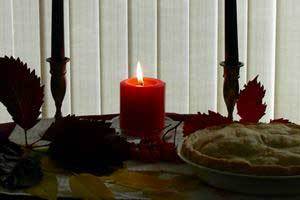If you have walked into a store recently looking for quality candles for your home you may feel overwhelmed. Candles come in all sizes, shapes, colors and now are made of several different waxes. I am going to try to unravel some of the mystery of buying the right candle for your home.
 It is important that you get the right candle for the purpose you have in mind. If you are looking for a dinner candle to burn for a half hour or so a candlestick might be what you are looking for, either a tapered candle or a straight sided candlestick. These work great for short power outages as well. If you are looking for a candle to burn for long periods try a pillar. If you like burning candles in little cups you can try burning a votive in a votive cup that fits snuggly around it. Tealights are great as well and depending on what kind of wax they are made of can burn for quite some time. No matter what candle you choose it is important to remember never leave a burning candle unattended.
It is important that you get the right candle for the purpose you have in mind. If you are looking for a dinner candle to burn for a half hour or so a candlestick might be what you are looking for, either a tapered candle or a straight sided candlestick. These work great for short power outages as well. If you are looking for a candle to burn for long periods try a pillar. If you like burning candles in little cups you can try burning a votive in a votive cup that fits snuggly around it. Tealights are great as well and depending on what kind of wax they are made of can burn for quite some time. No matter what candle you choose it is important to remember never leave a burning candle unattended.
Color is a matter of taste. Candles may be a significant part of your décor accenting or complementing colors. Some candles have non-toxic dyes. It is unlikely that you will find candles with wicks with zinc or lead in them but watch dollar store candles or old candles you’ve had around for a while. A test for zinc or lead in the wick is to look for a dark line through the wick. It could just be paper to give the wick some body but if it leaves a gray or black mark when rubbed on white paper it could be lead. You don’t want a wick that could be putting lead into the air as it burns. Preferably your wick is all cotton or cotton with a paper twist. If it has metal in it throw it away.
 Don’t be afraid to try some of the new shapes in candles particularly during the holidays. Do be aware that some of those shapes will not burn completely and you may have leftover wax. In some cases it is just small pieces flaking off as the candle burns, like this beeswax Yule Tree will sometimes. If they are small enough you can feed them back into the wax pool. If you like the decorative shapes look for the more compact shapes that will be more likely to burn efficiently and are less likely to have large chunks left unburned. If it is a smaller holiday decorative candle you are more likely to burn it all up through the holidays as well. No leftover Christmasy candles!
Don’t be afraid to try some of the new shapes in candles particularly during the holidays. Do be aware that some of those shapes will not burn completely and you may have leftover wax. In some cases it is just small pieces flaking off as the candle burns, like this beeswax Yule Tree will sometimes. If they are small enough you can feed them back into the wax pool. If you like the decorative shapes look for the more compact shapes that will be more likely to burn efficiently and are less likely to have large chunks left unburned. If it is a smaller holiday decorative candle you are more likely to burn it all up through the holidays as well. No leftover Christmasy candles!
One of the biggest decisions you will make when buying candles is the type of wax they are made of. The most common is paraffin. Here are the pros and the not so good things of going with paraffin.
Paraffin
Pros
- It is cheap
- Readily available
Not so Good
- From a non-renewable source
- Processed petroleum by-product
- Creates a large amount of black sticky soot that can cover your walls and cling in the air for your family to breath
- Polymers are added to raise the melting point and improve burning qualities
- Paraffin candles are known to drip without additives
- Often scented with artificial fragrance
- Often bleached and dyed with toxic colorants
Used long before paraffin candle wax and steeped in tradition and history is of course beeswax. Even long ago beeswax was expensive and only the wealthy or royalty were able to afford it. Today it is considered by many a worthwhile and affordable luxury. Here are the good things about beeswax and the not so good things.
Beeswax
Pros
- Non-carcinogenic
- Non-toxic
- Can be shipped in all weather conditions because of its high melt point
- Is thought to have air purifying qualities
- Burns cleanly
- Naturally long burning without additives
- Pure and natural
- On the light spectrum the light produced by the large bright flame is believed to be close to that of natural sunlight
Not so Good
- Considered pricier than other waxes
- Beeswax can be combined with other waxes to reduce manufacturing costs and still be called beeswax. Be sure to always look for 100% pure beeswax products
A newer wax on the market that is gaining popularity is soy wax for candles. In third world countries there have been some questionable environmental practices in the production of soy. In a year when the traditional soy growing areas in North America have been hard hit by drought and entire crops have been lost it might be worthwhile finding out if the soy wax you are purchasing is imported and if so is it produced in ethical and safe ways.
Soy Wax
Pros
- Renewable resource
- No known toxins in the raw wax
- Biodegradable
- Low melt temperature
- Non-carcinogenic
- Burns cleanly
- Can be cleaned up with soap and water
Not so Good
- Soy products are commonly Genetically Modified, bleached and hydrogenated
- Aesthetically, soy wax is not pretty and candles often develop bumps and lesions while burning
- On the light spectrum, soy candles have a cooler toned smaller flame
- Soy wax goes rancid without preservatives
- Some soy wax candles contain additives and hardeners
- Toxic pesticides are often used on soy crops
- Soy candle makers are limited by the type of candle they can make because the wax is so soft. They are unable to provide customers with pillars, tapers or ornamentals
- Requires vast amounts of agricultural land and processing
- Often scented with artificial fragrances
- Soy wax is difficult to ship during hot weather because it will melt
Palm wax like soy is a more recent wax on the market. It is very pretty and has a beautiful crystalline structure.
Palm Wax
Pros
- Palm crops require a lower input of fossil fuels compared to soy
- Beautiful crystalline structure to the wax.
- Palm oil production creates 3,200 kg oil/hectare per year and soybean production creates only 351 kg oil/hectare per year
- Entirely free of petroleum products
- Clean burning and soot free
- Toxin and carcinogen free
- Slow burning
- No additives are needed to prevent the wax from going rancid
- Renewable resource
- Not genetically modified
- By creating jobs in poorer countries it is thought to help eradicate poverty
Not so Good
- Must be imported (mostly from Malaysia)
- Pesticides are often used for palm plants
- Is perceived to be responsible for deforestation and displacement of many species of wildlife
- Like other natural waxes can be (and is by some popular candle makers) combined with paraffin which negates the benefits
So there you have it. Some points about the four most likely candle waxes you will be choosing from for candles for your home and for holiday gift giving. If you have any thoughts on this article I welcome your comments.










